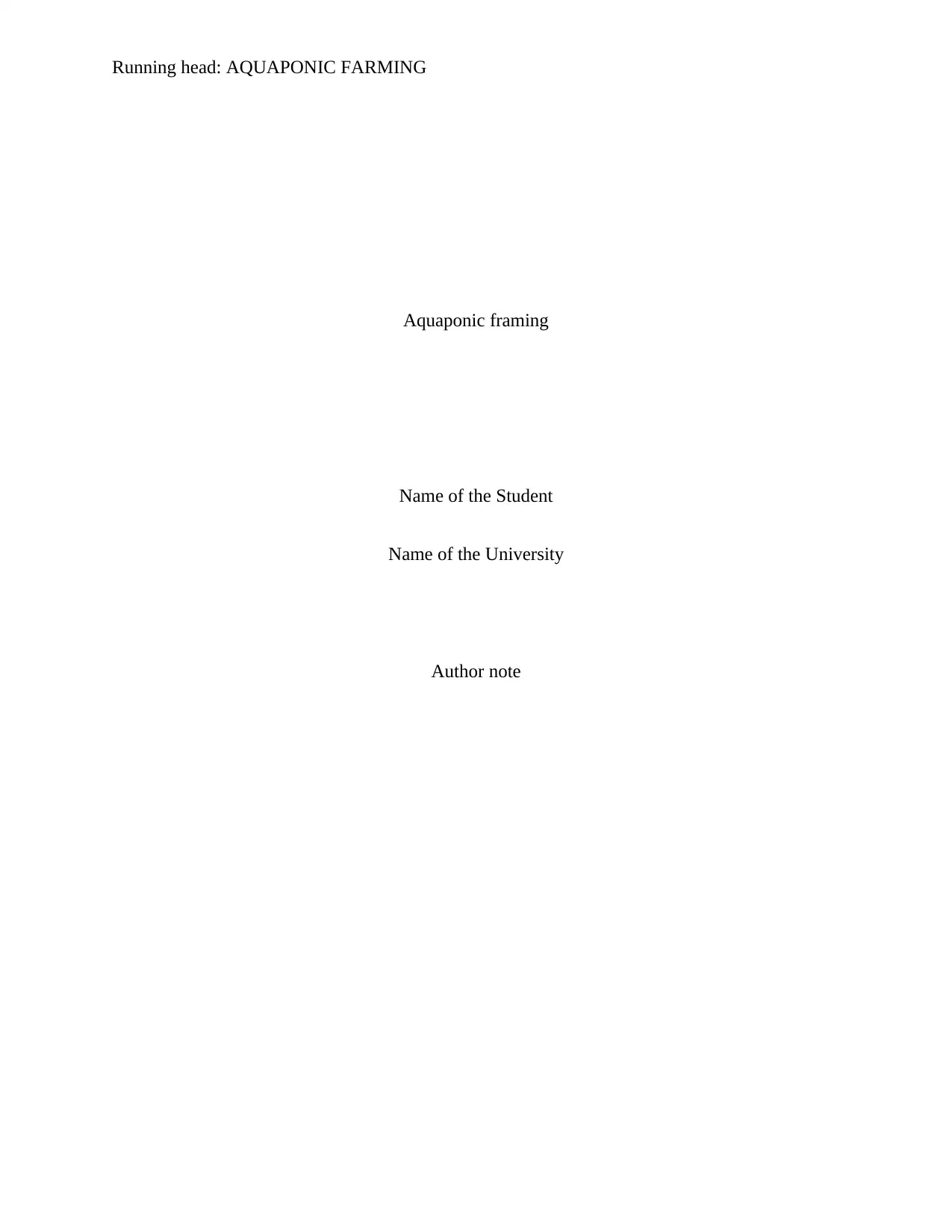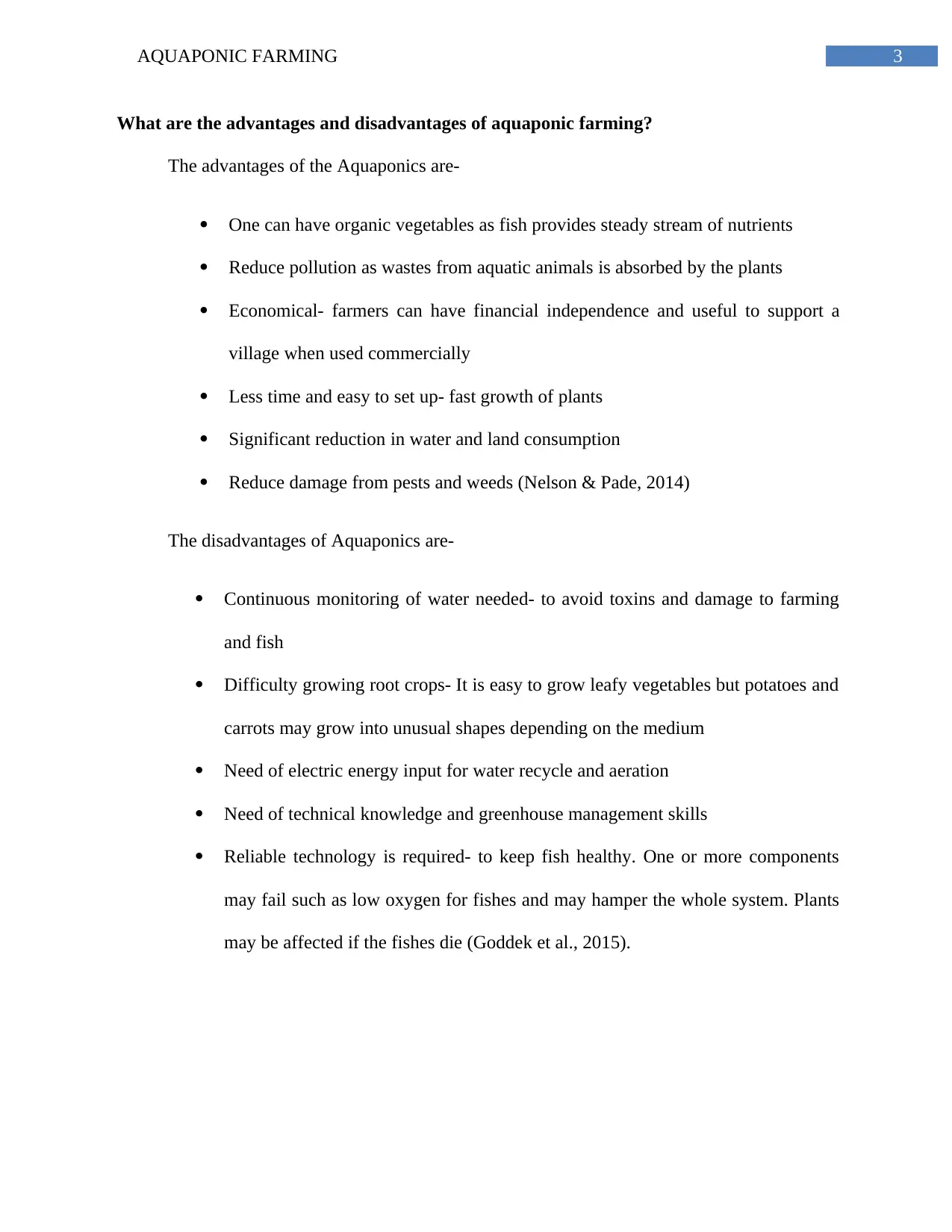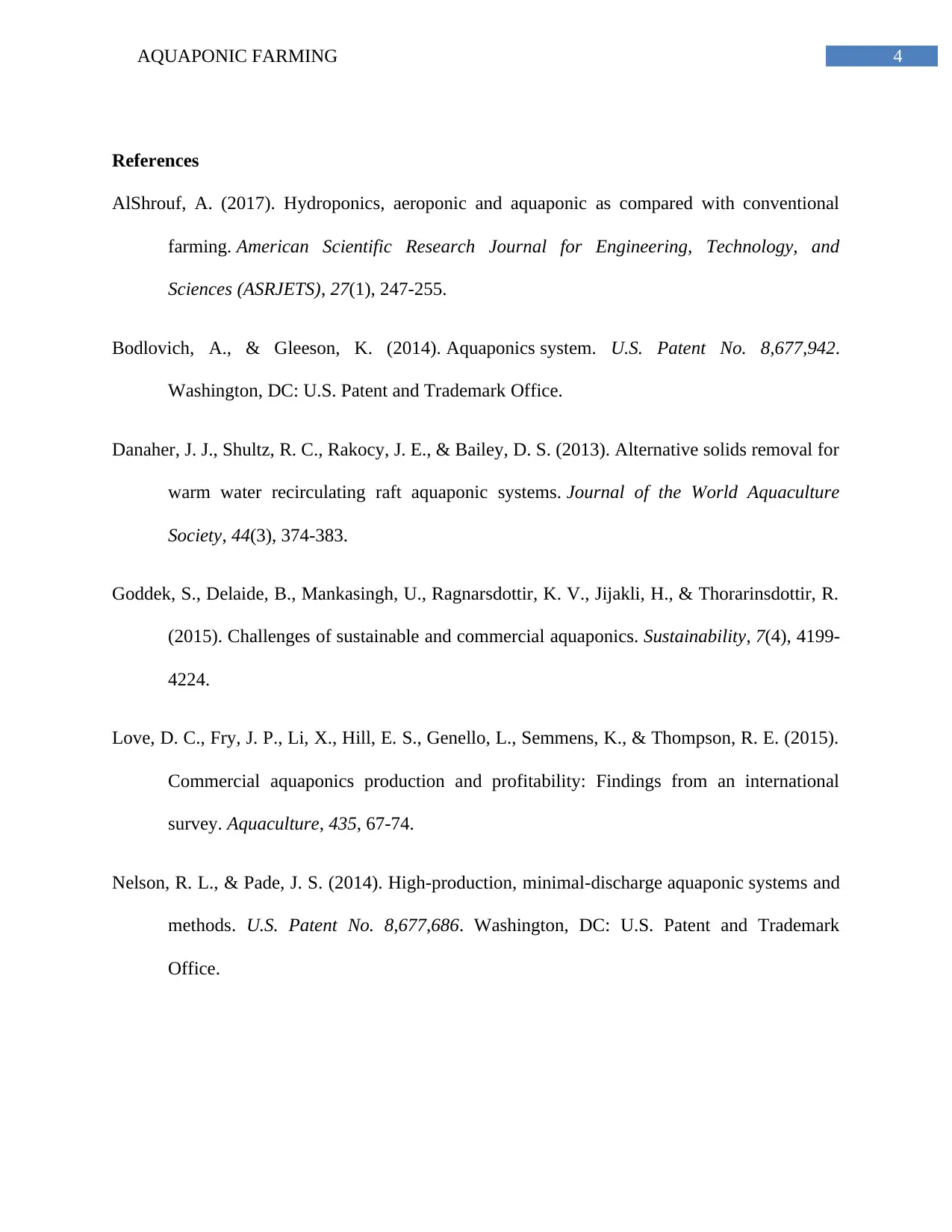Aquaponic Farming: A Comprehensive Overview of Sustainable Practices
VerifiedAdded on 2023/06/15
|5
|1142
|408
Essay
AI Summary
This essay provides a detailed overview of aquaponic farming, a sustainable method that combines aquaculture (raising aquatic animals) and hydroponics (growing plants in water). It explains the workings of an aquaponic system, including the roles of rearing tanks, settling chambers, biofilters, and hydroponic subsystems. The essay details how plants are fed and grown using nutrient-rich water from fish waste, which is converted into usable nitrates by beneficial bacteria. It also discusses the advantages of aquaponics, such as organic vegetable production, reduced pollution, and efficient use of resources, as well as its disadvantages, including the need for continuous monitoring, technical knowledge, and reliable technology. The essay references various studies to support its claims and provide a comprehensive understanding of aquaponic farming as a sustainable agricultural practice.

Running head: AQUAPONIC FARMING
Aquaponic framing
Name of the Student
Name of the University
Author note
Aquaponic framing
Name of the Student
Name of the University
Author note
Paraphrase This Document
Need a fresh take? Get an instant paraphrase of this document with our AI Paraphraser

1AQUAPONIC FARMING
Introduction
The assignment deals with the Aquaponic farming and the process involved in growing
plants and rearing fish. The assignment discusses how the plants feed and grow in aquaponic
farming. The advantages and disadvantages of this type of farming system are discussed.
What is Aquaponic farming?
Aquaponic farming is the combination of the hydroponics that is raising plants in the
water and aquaculture or fish farming. It is the sustainable method of growing vegetables and
raising fish. In this technique year round indoor farming is ensured as the negative aspects of
aquaculture and hydroponics can be eliminated (Love et al., 2015).
How dose aquaponic farming work?
There are two parts of the Aquaponic farming. In the aquaculture part the aquatic animals
are raised. In the hydroponic farming the plants are grown. The other main component of this
farming is the use of bacteria. In this type of farming a system called rearing tank is created that
mimics the ponds, rivers and lakes. In this tank the fishes are raised and fed. In the settling
chamber, the detached biofilm, uneaten food and fine particles are collected. The tank also
comprises of biofilter to convert ammonia using nitrification bacteria into nitrates that can be
used by the plants (Bodlovich & Gleeson, 2014). In the hydroponic subsystem of the tank, the
plants grow using nutrients from water, without soil. In turn the plants purify water, which is
utilised by fishes. The lowest point of the system called the sump, where water is continuously
pumped to rearing tank. The entire system is designed with enough precaution taken to prevent
the direct flow of water from the aquaculture part to the hydroponics part. In this farming use of
Introduction
The assignment deals with the Aquaponic farming and the process involved in growing
plants and rearing fish. The assignment discusses how the plants feed and grow in aquaponic
farming. The advantages and disadvantages of this type of farming system are discussed.
What is Aquaponic farming?
Aquaponic farming is the combination of the hydroponics that is raising plants in the
water and aquaculture or fish farming. It is the sustainable method of growing vegetables and
raising fish. In this technique year round indoor farming is ensured as the negative aspects of
aquaculture and hydroponics can be eliminated (Love et al., 2015).
How dose aquaponic farming work?
There are two parts of the Aquaponic farming. In the aquaculture part the aquatic animals
are raised. In the hydroponic farming the plants are grown. The other main component of this
farming is the use of bacteria. In this type of farming a system called rearing tank is created that
mimics the ponds, rivers and lakes. In this tank the fishes are raised and fed. In the settling
chamber, the detached biofilm, uneaten food and fine particles are collected. The tank also
comprises of biofilter to convert ammonia using nitrification bacteria into nitrates that can be
used by the plants (Bodlovich & Gleeson, 2014). In the hydroponic subsystem of the tank, the
plants grow using nutrients from water, without soil. In turn the plants purify water, which is
utilised by fishes. The lowest point of the system called the sump, where water is continuously
pumped to rearing tank. The entire system is designed with enough precaution taken to prevent
the direct flow of water from the aquaculture part to the hydroponics part. In this farming use of

2AQUAPONIC FARMING
hydroponics combining with biofiltertaion prevent the use of expensive biofilter. Thus, using the
vegetable grow bed aquaponics recirculates water from the fish tank (AlShrouf, 2017).
How the plants feeding and growing?
In Aquaponic farming, a suitable plant depending on the stocking density of fish and
maturity is selected. Green leafy vegetables such as lettuce, spinach are well accustomed to the
Aquaponics as they demand less nutrients. In order to grow tomatoes, peppers, cucumbers, a
mature Aquaponic system is required as they demand more nutrients. Therefore, higher stocking
density of fish is needed with mature tanks (Bodlovich & Gleeson, 2014).
Fishes are raised in nutrient rich water, which is useful for the plants as natural fertiliser.
Fish is the healthy source of protein for plants. The roots of plants are immersed in the “nutrient-
rich effluent water”. Plants extract nutrients from water and fish waste feed. The nutrients are
made available to plant roots through nitrification bacteria. These bacteria convert ammonia to
nitrate aerobically and reduce water toxicity for fish. Plants assimilate nitrates easily and grow
faster. Ammonia is initially converted into the nitrites by Nitrosomonas. The nitrites are then
converted into nitrates using Nitrobacter. This process eliminates the need of soil tilling.
In the Aquaponic system the deep water rafts are used to ensure that in one end seedlings
are transplanted, while other side is used to harvest plants. Pests are controlled by use of non-
chemical methods such as traps. Biological control includes use of parasitic wasps. The plant
roots are watered every alternate hour and they grow faster due to constant availability of high
amount of nitrates. There are different forms of growing the bed design for plants. The most
common one is the floating raft style and the flood-drain method (Danaher et al., 2013).
hydroponics combining with biofiltertaion prevent the use of expensive biofilter. Thus, using the
vegetable grow bed aquaponics recirculates water from the fish tank (AlShrouf, 2017).
How the plants feeding and growing?
In Aquaponic farming, a suitable plant depending on the stocking density of fish and
maturity is selected. Green leafy vegetables such as lettuce, spinach are well accustomed to the
Aquaponics as they demand less nutrients. In order to grow tomatoes, peppers, cucumbers, a
mature Aquaponic system is required as they demand more nutrients. Therefore, higher stocking
density of fish is needed with mature tanks (Bodlovich & Gleeson, 2014).
Fishes are raised in nutrient rich water, which is useful for the plants as natural fertiliser.
Fish is the healthy source of protein for plants. The roots of plants are immersed in the “nutrient-
rich effluent water”. Plants extract nutrients from water and fish waste feed. The nutrients are
made available to plant roots through nitrification bacteria. These bacteria convert ammonia to
nitrate aerobically and reduce water toxicity for fish. Plants assimilate nitrates easily and grow
faster. Ammonia is initially converted into the nitrites by Nitrosomonas. The nitrites are then
converted into nitrates using Nitrobacter. This process eliminates the need of soil tilling.
In the Aquaponic system the deep water rafts are used to ensure that in one end seedlings
are transplanted, while other side is used to harvest plants. Pests are controlled by use of non-
chemical methods such as traps. Biological control includes use of parasitic wasps. The plant
roots are watered every alternate hour and they grow faster due to constant availability of high
amount of nitrates. There are different forms of growing the bed design for plants. The most
common one is the floating raft style and the flood-drain method (Danaher et al., 2013).
⊘ This is a preview!⊘
Do you want full access?
Subscribe today to unlock all pages.

Trusted by 1+ million students worldwide

3AQUAPONIC FARMING
What are the advantages and disadvantages of aquaponic farming?
The advantages of the Aquaponics are-
One can have organic vegetables as fish provides steady stream of nutrients
Reduce pollution as wastes from aquatic animals is absorbed by the plants
Economical- farmers can have financial independence and useful to support a
village when used commercially
Less time and easy to set up- fast growth of plants
Significant reduction in water and land consumption
Reduce damage from pests and weeds (Nelson & Pade, 2014)
The disadvantages of Aquaponics are-
Continuous monitoring of water needed- to avoid toxins and damage to farming
and fish
Difficulty growing root crops- It is easy to grow leafy vegetables but potatoes and
carrots may grow into unusual shapes depending on the medium
Need of electric energy input for water recycle and aeration
Need of technical knowledge and greenhouse management skills
Reliable technology is required- to keep fish healthy. One or more components
may fail such as low oxygen for fishes and may hamper the whole system. Plants
may be affected if the fishes die (Goddek et al., 2015).
What are the advantages and disadvantages of aquaponic farming?
The advantages of the Aquaponics are-
One can have organic vegetables as fish provides steady stream of nutrients
Reduce pollution as wastes from aquatic animals is absorbed by the plants
Economical- farmers can have financial independence and useful to support a
village when used commercially
Less time and easy to set up- fast growth of plants
Significant reduction in water and land consumption
Reduce damage from pests and weeds (Nelson & Pade, 2014)
The disadvantages of Aquaponics are-
Continuous monitoring of water needed- to avoid toxins and damage to farming
and fish
Difficulty growing root crops- It is easy to grow leafy vegetables but potatoes and
carrots may grow into unusual shapes depending on the medium
Need of electric energy input for water recycle and aeration
Need of technical knowledge and greenhouse management skills
Reliable technology is required- to keep fish healthy. One or more components
may fail such as low oxygen for fishes and may hamper the whole system. Plants
may be affected if the fishes die (Goddek et al., 2015).
Paraphrase This Document
Need a fresh take? Get an instant paraphrase of this document with our AI Paraphraser

4AQUAPONIC FARMING
References
AlShrouf, A. (2017). Hydroponics, aeroponic and aquaponic as compared with conventional
farming. American Scientific Research Journal for Engineering, Technology, and
Sciences (ASRJETS), 27(1), 247-255.
Bodlovich, A., & Gleeson, K. (2014). Aquaponics system. U.S. Patent No. 8,677,942.
Washington, DC: U.S. Patent and Trademark Office.
Danaher, J. J., Shultz, R. C., Rakocy, J. E., & Bailey, D. S. (2013). Alternative solids removal for
warm water recirculating raft aquaponic systems. Journal of the World Aquaculture
Society, 44(3), 374-383.
Goddek, S., Delaide, B., Mankasingh, U., Ragnarsdottir, K. V., Jijakli, H., & Thorarinsdottir, R.
(2015). Challenges of sustainable and commercial aquaponics. Sustainability, 7(4), 4199-
4224.
Love, D. C., Fry, J. P., Li, X., Hill, E. S., Genello, L., Semmens, K., & Thompson, R. E. (2015).
Commercial aquaponics production and profitability: Findings from an international
survey. Aquaculture, 435, 67-74.
Nelson, R. L., & Pade, J. S. (2014). High-production, minimal-discharge aquaponic systems and
methods. U.S. Patent No. 8,677,686. Washington, DC: U.S. Patent and Trademark
Office.
References
AlShrouf, A. (2017). Hydroponics, aeroponic and aquaponic as compared with conventional
farming. American Scientific Research Journal for Engineering, Technology, and
Sciences (ASRJETS), 27(1), 247-255.
Bodlovich, A., & Gleeson, K. (2014). Aquaponics system. U.S. Patent No. 8,677,942.
Washington, DC: U.S. Patent and Trademark Office.
Danaher, J. J., Shultz, R. C., Rakocy, J. E., & Bailey, D. S. (2013). Alternative solids removal for
warm water recirculating raft aquaponic systems. Journal of the World Aquaculture
Society, 44(3), 374-383.
Goddek, S., Delaide, B., Mankasingh, U., Ragnarsdottir, K. V., Jijakli, H., & Thorarinsdottir, R.
(2015). Challenges of sustainable and commercial aquaponics. Sustainability, 7(4), 4199-
4224.
Love, D. C., Fry, J. P., Li, X., Hill, E. S., Genello, L., Semmens, K., & Thompson, R. E. (2015).
Commercial aquaponics production and profitability: Findings from an international
survey. Aquaculture, 435, 67-74.
Nelson, R. L., & Pade, J. S. (2014). High-production, minimal-discharge aquaponic systems and
methods. U.S. Patent No. 8,677,686. Washington, DC: U.S. Patent and Trademark
Office.
1 out of 5
Your All-in-One AI-Powered Toolkit for Academic Success.
+13062052269
info@desklib.com
Available 24*7 on WhatsApp / Email
![[object Object]](/_next/static/media/star-bottom.7253800d.svg)
Unlock your academic potential
Copyright © 2020–2025 A2Z Services. All Rights Reserved. Developed and managed by ZUCOL.


